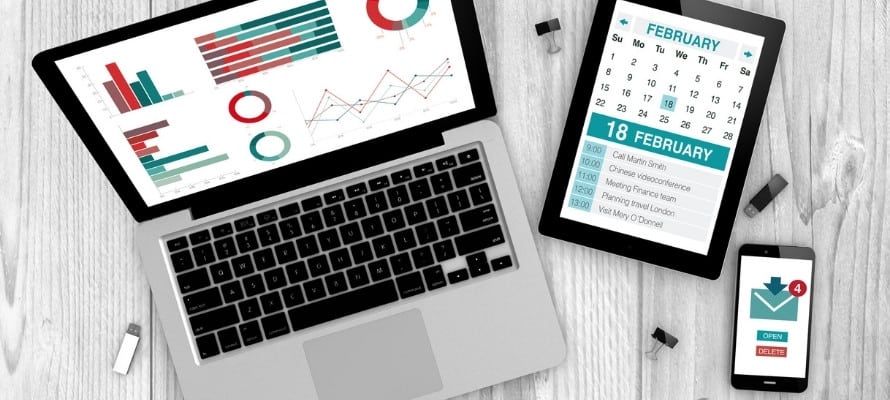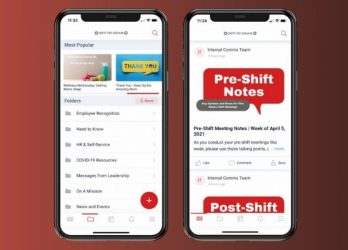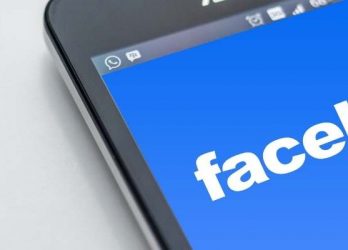Last updated on March 7, 2024 at 10:53 am
Bring your own device (BYOD) has changed the game. Companies that tap into BYOD save money, while simultaneously giving their employees the power to use their own technology to get work done and stay more connected to the business. This is especially key for frontline workers who are rarely issued company devices and have limited access to internal communication. But bring your own device solves that challenge. So, why is it that there are still so many misconceptions about BYOD?
As a former internal communications professional at Chipotle, I helped improve internal comms with our restaurant team by letting our deskless employees use their own smartphones to receive company communications. So, I want to talk about the top 5 myths about BYOD and set the record straight.
But before we dive into the myths, let’s start with some context.
What is Bring Your Own Device (BYOD)?
Bring Your Own Device (BYOD) is a policy that states that employees can use their own personal phones, computers, or other devices for work. It is also sometimes referred to as bring your own phone (BYOP) or bring your own technology (BYOT).
Companies started embracing BYOD policies as smartphone ownership became the norm. Everyone is walking around with this powerful technology literally in their pockets. It doesn’t make as much sense anymore to issue company phones, especially when you have a very large workforce. Embracing BYOD can save your company a ton of money, while also giving your employees access to important information.
Bring Your Own Device Myths
Like with any workplace technology, it’s important to understand the pros and cons. So, what are the top 5 concerns about BYOD and how valid are they?
1. Employees won’t want to use their personal device for work.
The first myth is that employees will just straight up reject BYOD. They won’t want their personal devices being used for work—it just crosses a line.
The truth is: 4 out of 5 frontline workers are willing to use their personal phone for work.
That said, of the 18% who weren’t comfortable with BYOD, their number one reason was that they wanted work-life separation. But that’s okay. It’s unreasonable to expect 100% of your employees to be on board with everything. The technology adoption curve is a great example of this. With any new technology or process you introduce, you’re going to have stages of adoption.
Are there going to be some employees who don’t want to use their personal devices? Sure. But it won’t be the majority.
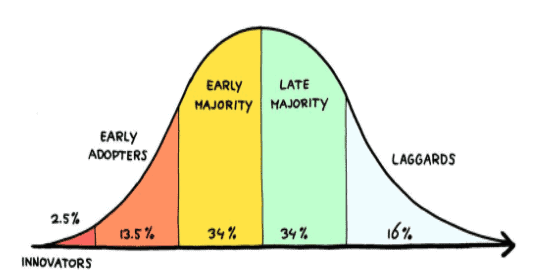
But most of your employees will be excited to finally have access to information. Kreg Tool Company experienced the same thing. Half their staff works in an office and half works in the plant. And these two groups did not have access to the same channels.
“We did a survey early on and we got a lot of great feedback that indicated people were really excited about the potential of having an app so they could all be informed about what was going on at the same time.”
—Melany Stonewall, Strategic Communications Manager, Kreg Tool Company
A majority of employees will be on board with BYOD right away. But some might need more convincing. That’s why we also have a mobile intranet and SMS texting to reach employees with different comfort levels.
2. Bring your own device invades employee privacy.
The thought here is that employees have been burned too many times. They don’t want their employers monitoring them or spying on them. Everyone has a right to have privacy and the contents of their phone kept private.
While there are certainly some companies or apps that have poisoned the well and do collect and misuse personal information, it’s not the majority. But this has created a misconception that everyone does this. theEMPLOYEEapp actually collects very little user data and mobile device preferences. We even have an option to turn off user data completely.
When companies are challenged with the topic of adopting BYOD or Mobile Device Management (MDM), the concern can be two-fold. Employee’s are focused on the fear of “big brother” monitoring them and employers are focused on restricting access to sensitive internal files and corporate systems for those without MDM.
Those concerns have been addressed in the marketplace with the advent of new capabilities within Apple and Android. Both platforms have taken strides to address each side of the argument around BYOD vs. MDM programs, resulting in a renewed industry push for secure BYOD adoption.
PRO TIP: If you are considering a mobile app solution for communication, we would advise you to ask them what their specific policy is on user data collection, storage, and use. We encourage all companies to be transparent about how they can remotely access or wipe an employee’s personal files, too.
3. Employees will expect to be compensated for using their phones.
Where this myth comes from isn’t hard to understand. Of course, companies will worry about employees opting out of BYOD because of the cost associated with their phones.
But remember, 82% are on board with BYOD and their top reasons are:
- It’s more convenient to use their own phone
- Feeling generally indifferent and don’t care about privacy, cost, etc.
- They want more access to communication, their colleagues, and information
- They really don’t want a second phone
So, your employees aren’t as concerned about you paying their phone bill as you might think.
Okay, but what about time worked, time paid concerns. If you’re asking employees to use an app or other tools on their personal phones, what if they are hourly and use those tools off the clock? Where do you stand legally?
Luckily, this is something we help our clients navigate all the time. Since we are mostly working with companies with primarily deskless workers who are hourly, it is important to let your employees know that BYOD is optional.
Because this is a big legal concern, we offer a customizable privacy policy that employees must acknowledge when they log into our app/intranet for the first time. It’s common for clients to include in that agreement that the app does not count as compensatory time.
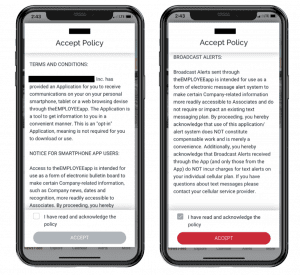
4. Employees using their phones at work is too distracting.
BYOD doesn’t mean all rules go out the window for phone use at work. If you have a no phones on the floor rule, that still stands. None of that changes. Employees should still use their phones off the floor and in the break room. And remember, employees may want to check the app from home to learn about their benefits, payroll, their schedule, etc.
But consider this: many of our clients in healthcare, logistics, and even manufacturing have found that improving communication and access to resources has only improved efficiency and made it easier for employees to do their jobs.
Avera Health, for example, used their app to get rid of their paper system during the COVID-19 pandemic. The app let them digitize to be more sanitary and effective. But they couldn’t have done that if their employees couldn’t use their phones for work.
5. Older employees don’t own a smartphone.
This is a pretty dangerous stereotype and simply not true. Some employees might need a little more training on your tools and channel than others, but the data on smartphone ownership is pretty cut and dry.
A staggering 97% of adults in the U.S. own a smartphone.
Many of our clients have looked into their company demographics to make sure mobile-first channels and BYOD is a good fit. And here’s what they’ve found:
“What it ultimately came down to is that almost everybody has a smartphone and are fairly familiar with using apps. We knew it wouldn’t require a lot of training to get people up to speed on how to use it. And the employee app is so intuitive to use that it just really made sense for us.”
—Melany Stonewall, Strategic Communications Manager, Kreg Tool Company
“Working at a company that’s been around the last 40 years, it’s really difficult to bring in a new product, especially something digital like this app. But we have been able to give our associates a tool they haven’t had for the last 40 years.”
—Anonymous client in the automotive manufacturing industry
Bring Your Own Device: Embracing the Mobile Revolution
Mobile employee communication channels are by far the fastest growing channel. That’s partly due to the accessibility of smartphone and mobile technology. But it’s also because of shifting preferences.
Now that Millennials and Gen Z make up the majority of the workforce, the way we work is shifting. These generations largely grew up with technology and immediate access to each other and information. And they’re expecting the same at work.
Companies are racing to meet those expectations! In 2021, 44% of frontline workers said they had access to texting as a channel and 16% had an employee app. Those numbers jumped to 57% with texting and 25% with an app. Are you ready to embrace mobile-first communication?
Subscribe To The theEMPLOYEEapp Newsletter
Comments are closed.

